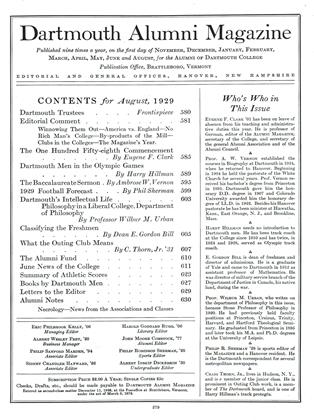Professor William M. Sloane of Princeton, a member of the International Olympic Committee, brought the United States into the first Olympics, and largely through his initial efforts our interest has been maintained.
In 1896 the United States was represented in the athletic competition by a small group of athletes, competing for their different colleges and clubs, and more or less unorganized. In 1900 the same method was followed, as was the case in St. Louis in 1904, where the competition, although having an international flavor, developed into competition between the several sections of the United States. In 1906 the first officially organized team was sent to Athens as representatives of the country and wearing the emblem of the Stars and Stripes, and this group consisted of forty athletes sent over at a cost of less than $15.000 the funds having been raised by popular subscription, which is still the American way of sending their competitors abroad. Every four years since the 1906 games, the American team has grown in numbers and has participated in the majority of the activities, including winter sports, hockey, wrestling, boxing, lacrosse, swimming (both men and women), water polo, gymnastics, fencing, rowing, modern pentathlon, equestrian, yachting, cycling and track and field (men and women).
The American Olympic Team that represented the United States at Amsterdam last summer consisted of about 400 persons and the cost of the trip was $290,000. This good-sized team was of necessity transported and housed aboard a large United States Lines Steamshipthe President Roosevelt.
The United States has been returned winner in the nine Olympic contests that have been held, but each year the competition gets keener, and although there was much unwarranted criticism of the showing of the athletes, as well as the management in the last Olympics, there is no denying the fact that every one, athletes and others, did the best they could under rather trying circumstances. Furthermore the caliber of the foreign athletes in the 1928 Olympics was just as good and sometimes better than our own athletes.
The teams of 1896, 1900, 1904 and 1906 were composed mostly of ex-college and athletic club athletes, but increasingly since this time, college athletes have come to the front very rapidly, and according to statistics they are now the foundation of our Olympic Teams. In 1908, 56% of the points scored by America in the athletic events were won by college men; in 1912, 63%; in 1920, 70%; in 1924, 86% and in 1928, 93% of the point winners were college or ex-college athletes, so you can readily see that the college athlete in recent years has been upholding the athletic prestige of our coun try. However, unless the college athlete can be interested to continue athletics after his graduation, the future does not look too good, as in many of the Olympic events we need more matured athletes, especially in the long distance running events. Twenty years ago the American long distance runners could hold their own in international competition, but of recent years our showing in these events has been very poor. Unless some remedy is found before 1936, there is not the least doubt that Germany will be a strong contender in Olympic competition, because they have instituted a program in athletics that interests all classes. Instead of the military training in vogue for so many years in Germany, an athletic policy has been substituted and they are going ahead rapidly. In the 1928 Olympics at Amsterdam, only lack of campaigning and inexperience prevented Germany from giving America a real tussle. Give them eight more years and we must then be prepared for vigorous competition.
CARLTON AND BOWLER
EARL J. THOMPSON Holder of world's record in high hurdles
 View Full Issue
View Full Issue
More From This Issue
-
 Class Notes
Class NotesCLASS OF 1879
August 1929 By Henry Melville -
 Article
ArticleAlumni Council Meetings
August 1929 -
 Article
ArticleThe One Hundred Fifty-Eighth Commencement
August 1929 By Eugene F. Clark -
 Class Notes
Class NotesCLASS OF 1899
August 1929 By Warren C. Kendall -
 Class Notes
Class NotesCLASS OF 1903
August 1929 By John Crowell -
 Class Notes
Class NotesCLASS OF 1918
August 1929 By Frederick W. Cassebeer
Harry Hillman
-
 Sports
SportsHOW THE OLYMPICS BEGAN
AUGUST 1929 By Harry Hillman -
 Sports
SportsTHE REVIVAL IN 1896
AUGUST 1929 By Harry Hillman -
 Sports
SportsTHE GAMES BEGIN
AUGUST 1929 By Harry Hillman -
 Sports
SportsDARTMOUTH IN THE OLYMPICS
AUGUST 1929 By Harry Hillman -
 Article
ArticleA New Hurdle
MARCH 1931 By Harry Hillman -
 Sports
SportsVARSITY TRACK
January 1942 By Harry Hillman








